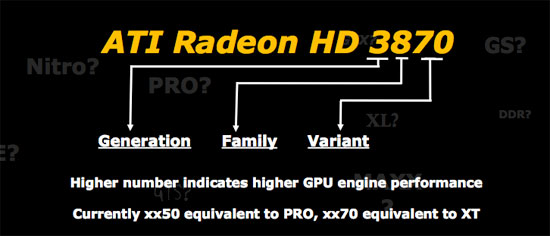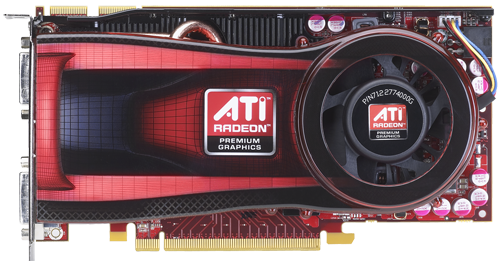Faster Graphics For Lower Prices: ATI Radeon HD 4770
by Derek Wilson on April 28, 2009 5:15 AM EST- Posted in
- GPUs
First things first: the Radeon HD 4770 is faster than existing 4800 series hardware (namely the 4830). Yes, this is by design.
We hate to start another article complaining about naming (there seems to be some sort of pervasive renaissance of poor naming this year), but let's talk about why exactly we are in this situation with a look back at something from our RV670 coverage:

At least it's ironic.
Yes, the problem is born out of AMD's attempt at sensible, appropriate naming. The problem is that AMD seems to want to associate that "family" number with the physical GPU than with the a performance class. This is despite the fact that they generally use increasing numbers for "families" that are generally faster. Thus, the 40nm RV740 needs a new family name, and they can't really choose 49xx presumably (by us) because people would be more upset if they saw a high number and got lower performance than if they saw a lower number and got higher performance. So Radeon HD 4770 it is.

When we brought up our issues with the naming scheme, AMD was quick to respond that naming is one of the most contentious things that go on in bringing a graphics card to market. People get passionate about the issue. Passion is great, but not if it confuses, misleads, or distracts the end user. And that's what a decision like this does. There is no practical reason that this card shouldn't be named 4840 to reflect where it's performance falls. After all, the recently released 4890 is host to quite a few tweaks to the physical layout of the chip and it isn't called the 4970.
At the same time, that trailing zero is doing nothing on all AMD hardware. There is an extra number in there that could allow AMD to shift some things around in their naming scheme to retain all the information they want to reflect about architecture generation, processes revision, performance class and specific performance within that class. If we are going to have a model number system, in order to have real value to both the informed and casual graphics card user it needs to be built to properly represent the underlying hardware AND be strictly related to performance. With this move, AMD joins NVIDIA in taking too many liberties with naming to the detriment of the end user.
Now that that's taken care of, what we have today is a 40nm GPU (the first) paired with 512MB of RAM on a $110 card. The package delivers performance at a level between the 4830 and the 4850. First indications were that this would be a $99 part and the performance we see with this card at the "magic" price would be terrific. It's still not bad at a 10% higher price. AMD had indicated that there should be some $10 mail in rebates available for those who are interested in the extra bonus hassle and upfront cost to get the cash.










88 Comments
View All Comments
Luminair - Tuesday, April 28, 2009 - link
whose power readings are correct, anandtech or hardocptomoyo - Tuesday, April 28, 2009 - link
Ya the power readings are all over the map here. Xbitlabs has the 4770 with MUCH lower idle power than the 4830. While Anandtech shows the 4770 consuming more at idle. Something is strange with the power measurements of this graphics card.RagingDragon - Wednesday, May 13, 2009 - link
Everbody is measuring system power consumption at the wall socket instead of GPU power consumption; therefore, power comsumption varies since each site uses different CPU's, motherboards, powersupplies, etc.kmmatney - Tuesday, April 28, 2009 - link
I haven;t read the XBitLab article yet, but they normally use a technique where they directly measure the power draw of the card, rather than the entire system. I believe they are more accurate. I'll read their article now, since it probably has OVERCLOCKING!!! How could AT miss that - at least OC and run one benchmark so we can see the percentage gain.tomoyo - Tuesday, April 28, 2009 - link
Looking at HARDocp's power results, they don't make sense. Supposedly their system without video card is 46 watts from the wall and system with 4770 is 53 watts? There's no way the idle is 7 watts for the video card including psu inefficiencies. This contradicts greatly with xbitlabs and anandtech...which already both contradict each other regarding power usage. Basically none of the power results can be trusted which is really annoying.Korr - Tuesday, April 28, 2009 - link
What a terrible piece. This is the exact reason why I rarely visit AT anymore. One resolution per game tested? No overclocking? One page of text to whine about the name?Please never review computer hardware again.
aeternitas - Wednesday, June 10, 2009 - link
I guess simple graphs are still too complex for some people to understand. lolJarredWalton - Tuesday, April 28, 2009 - link
Don't know about you, but I see resolution scaling charts showing 1280x1024, 1680x1050, and 1920x1200.7Enigma - Wednesday, April 29, 2009 - link
B...B...But the other resolutions don't have pretty bar graphs! Seriously don't feed these trolls. If they can't even READ the review before blasting it for things included, they don't deserve to get answered.AtenRa - Tuesday, April 28, 2009 - link
Personally I don’t mind about the naming of the card.Although this card is the first 0.40nm and it’s the first time the GPUs are manufactured using a smaller process than CPUs, I don’t see the reviewers to be exited for this product. I mean this review feels like it was made in 15 minutes just for having it in the site. No O/C and no CrossFire results. Have you ever wandered if 2 x 4770 are faster than a 4890?? how about 3 x 4770 ??